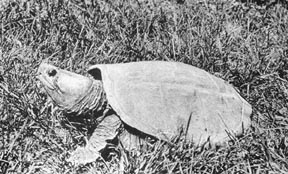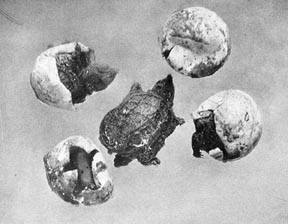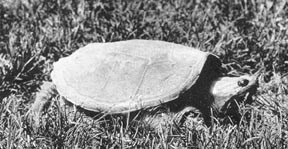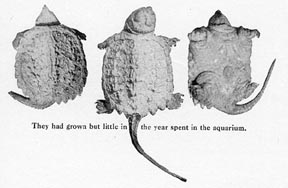THE HATCHING OF THE TURTLES
page 127 HORSESHOE BEND was a long, shallow pond about a half mile from the Naturalist’s home. Here the boys and girls of the neighborhood had loved to gather for skating parties on bright winter days when he was a boy. Here also, in summer, he found many interesting creatures who belonged to quite a different world from the little wood. Beautiful dragon flies who spent their days flying about in the bright sunlight, laid their eggs on the stems of water plants, just below the surface, and the young, when hatched, were true water babies. Frogs sang a regular chorus every summer night and whirligig beetles spun round and round in dizzy circles, while water striders skated on the surface of the pond in summer, as the boys and girls had done in the winter. These and other creatures of the water world told their stories to the Naturalist in the same language as the creatures of the little wood, but their stories must wait until a later time to be told.
Among the many inhabitants of the pond were two old turtles. The Naturalist knew they must be very old, since they were so much larger than any other turtles living there, or in the Nishnabotna River near by. Turtles grow slowly and live longer lives than any others of the backdoor neighbors. They lived in the pond for many years--how long nobody knew. When the snow melted and the ice went out in spring, the Naturalist would look for the old turtles, and, sure enough, they would be there. One spring when the Naturalist was still a boy, he had taken one of the turtles home with him and secured him with a chain. A hole in the edge of his shell furnished a secure place to fasten the snap, and for many a day the old turtle dreamed of his mate in the little pond. Finally, tiring of his pet, the Naturalist released the turtle on the hill, instead of returning him to his home in the pond. The pond was half a mile away, and to get there it was necessary to pass several woven wire fences, and to cross the river. The fences presented many difficulties, for they were built to turn small pigs which were not as large as the old turtle. Just how many hours of patient looking to find a way through were necessary would be hard to tell. The young Naturalist supposed that one pond would be as good as another for a turtle, and like most boys, gave little heed to the difficulties that lay in the way of finding any water at all. How-ever, when he visited the pond again some days later, he was much surprised to find the old turtle there again in his accustomed place. As the Naturalist grew older, he came to understand that wild creatures have many things in common with us. Love of home, freedom, and kindred is stronger in some than in others, but all have feelings worthy of respect. As years passed by and he learned more and more of their secrets, he came to have a great fear of making unnecessary pain even for the most insignificant worm, and would suffer much inconvenience in the way of damaged garden or shrubbery before he could bring himself to persecute the little creatures, which, he felt, had as good a right to live their lives as he.
Every year, in the month of June, Mother Snapping Turtle left the water and took a little journey. To see her quietly on her way few would guess the object of her quest. She was seeking a suitable place to lay her eggs and leave them to be hatched by the warmth of the sun’s rays. She sought a sandy spot where there was good drainage. The sand was warmer than the dirt, and, probably for this reason as much as anything, it furnished better conditions for the purpose she desired.
When she found such a place as suited her notion she would hollow out a hole five or six inches, or more, in depth and then deposit all her eggs at one time. If she came and laid one each day as birds do, several weeks’ time would be necessary, for Mother Snapping Turtle lays from twenty to forty eggs. When the eggs are all in the hole she covers it very carefully, leaving little outward evidence of the presence of her treasure, and returns again to the water, without further thought or care as to the fate of her offspring.
The eggs do not hatch until September, and when hatching time finally comes, there must be a grand scratching among the youngsters that find themselves thus buried beneath the surface. The little fellows dig out of their cavern and find their way to the water where their lives will be spent.
Sometimes the Naturalist guessed the secret of Mother Snapping Turtle and found her nest. Knowing about the time when she would be making her journey in search of a nesting place, he would spend some of the warm afternoons during the middle of June in the vicinity of the pond or the river where the snapping turtles lived. Sometimes he would surprise her in the act of laying her eggs. If disturbed, she would try to hide by drawing her head as far back as possible into her shell, and later make off to the water without covering her eggs.
One spring he decided that it would be very nice to raise a family of turtles himself, so he carefully took the eggs, which were round as marbles and about an inch in diameter, and placed them in a box of sand near the “Bug-house.” The box of sand was kept in the open sunshine, where it was kept warm by the sun and moist by the rains of summer. When at last September came, and the time drew near for the little turtles to appear, he carefully removed the sand from above them, leaving only a very thin layer which would betray any movement from beneath.
He had not long to wait, for soon the eggs began to crack. Instead of pipping in the manner of hen’s eggs when the young chicks are hatching, they opened across one side, as can be seen in the picture. More sand was then removed, so that the Naturalist and the boys could see what was going on. As soon as an egg cracked open, a little nose would be pushed out, and there Baby Turtle would sit for hours. Not the slightest haste was manifested, and the watchers at times became tired of waiting so long for any new action. After waiting for a long time one foot would be pushed through the hole, and after another long delay, the second foreleg would also appear. There it would remain half way out of the shell for hours longer. At last it would deliberately crawl free from the shell, and, since it was so far from the water, the Naturalist would place it in a shallow aquarium. Two or three days elapsed from the time the first egg opened until the last baby turtle was out of its shell. They took very kindly to the quarters provided for their benefit and greedily ate the flies and other insects which the boys supplied as food.
They spent much time resting on flat stones with their noses out of the water. Sometimes they would bury themselves in the soft sand on the bottom of the aquarium and remain there for long periods of time. When the cold days came and winter drew near they became less active and took less food. Finally, when the ponds and streams froze up, they refused food altogether, although they were kept in a warm room by the fire. They became very quiet and slept in the sand in the bottom of the aquarium much as Mother Snapping Turtle was doing in the mud at the bottom of Horseshoe Bend.
When spring came they were lively again and greedily ate the flies. Toward fall the Naturalist decided that they should no longer be compelled to live in such a little pond, but that they should be free to grow as big as their mother. They had grown but little in the year spent in the aquarium, probably from lack of proper food, although these reptiles do not make very much growth in a single year. One day they were taken to the river and released in the water by the bridge. They were quick to appreciate the larger freedom and immediately disappeared beneath the muddy water.
Next Chapter
Book Contents
Return to Bob' Page



